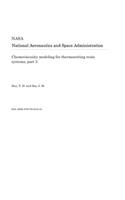
Chemoviscosity Modeling for Thermosetting Resin Systems, Part 3
Series:
A new analytical model for simulating chemoviscosity resin has been formulated. The model is developed by modifying the well established Williams-Landel-Ferry (WLF) theory in polymer rheology for thermoplastic materials. By introducing a relationship between the glass transition temperature (T sub g (t)) and the degree of cure alpha(t) of the resin system under cure, the WLF theory can be modified
3
VOLUME
English
Paperback

A new analytical model for simulating chemoviscosity resin has been formulated. The model is developed by modifying the well established Williams-Landel-Ferry (WLF) theory in polymer rheology for thermoplastic materials. By introducing a relationship between the glass transition temperature (T sub g (t)) and the degree of cure alpha(t) of the resin system under cure, the WLF theory can be modified to account for the factor of reaction time. Temperature-dependent functions of the modified WLF theory parameters C sub 1 (T) and C sub 2 (T) were determined from the isothermal cure data. Theoretical predictions of the model for the resin under dynamic heating cure cycles were shown to compare favorably with the experimental data. This work represents a progress toward establishing a chemoviscosity model which is capable of not only describing viscosity profiles accurately under various cure cycles, but also correlating viscosity data to the changes of physical properties associated with the structural transformations of the thermosetting resin systems during cure. Hou, T. H. and Bai, J. M. Unspecified Center NAS1-18000; RTOP 505-63-01-01...
Price Comparison [India]
In This Series
Bestseller Manga
Trending NEWS




















